Home / Enantiomers vs Diastereomers vs The Same? Two Methods For Solving Problems
Stereochemistry and Chirality
Enantiomers vs Diastereomers vs The Same? Two Methods For Solving Problems
Last updated: March 26th, 2025 |
Are These Molecules Enantiomers, Diastereomers or The Same?
- A classic exam question is to determine whether two molecules are enantiomers, diastereomers or the same.
- This is important not only in the chapter on stereochemistry, but will also become important once you learn the reactions of alkenes.
- Recall that isomers are two molecules that have the same molecular formula. Constitutional isomers have the same molecular formula, but different connectivity. Stereoisomers have the same connectivity, but different arrangement in space.
- Enantiomers are stereoisomers that are non-superimposable mirror images. Diastereomers are stereoisomers that are not non-superimposable mirror images. Also, in organic chemistry, two molecules that are superimposable upon each other are considered to be identical.
- One common method of determining whether molecules are “enantiomers, diastereomers, or the same” is to build the two molecules using a model kit and compare them. This can be helpful in the beginning, especially if the molecules are drawn in different representations (e.g. Fischer vs. Newman)
- In the longer term, it can be extremely helpful to get good at identifying the chiral centers in each molecule and determining their absolute configuration (i.e. R or S).
- This takes slightly longer to learn in the short term but pays big benefits iin the longer term, because once you know the designation of each chiral center, it’s easy to determine their relationships.
- Enantiomers always have the same connectivity but opposite R, S designations (e.g. the enantiomer of (2R, 3R)-tartaric acid is (2S, 3S)-tartaric acid.
- Diastereomers also have the same connectivity but share the same configuration on at at least one but not all chiral centers (e.g. a diastereomer of (2R, 3R) tartaric acid is (2R, 3S) tartaric acid.
- If the connectivity of the two molecules is the same, and the configurations of all the chiral centers are the same, the two molecules are identical .
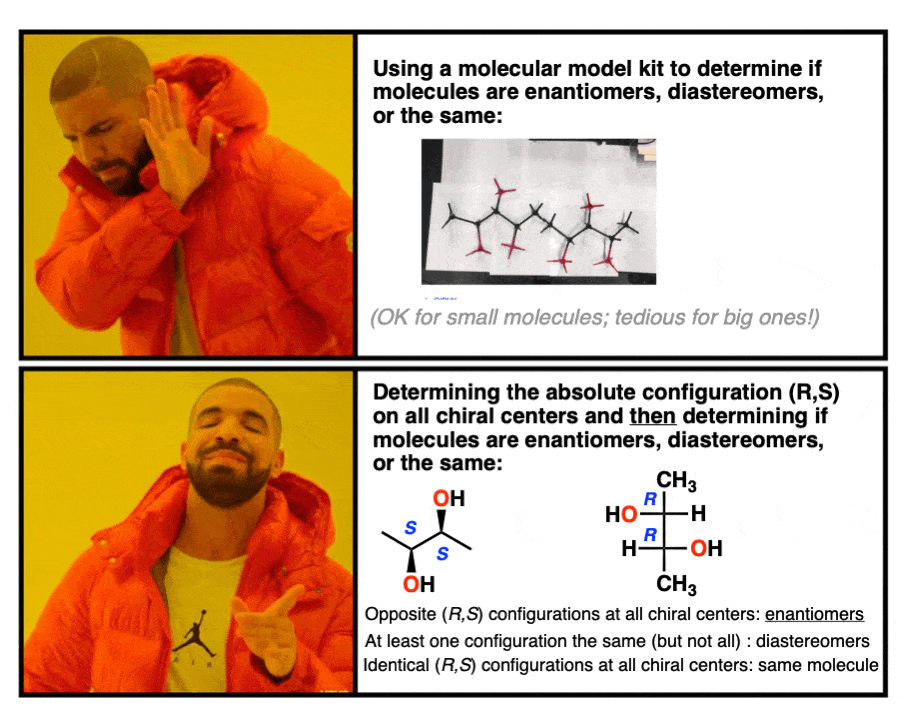
Table of Contents
- The key distinctions: isomers vs. non-isomers, constitutional isomers vs. stereoisomers, and enantiomers vs. diastereomers.
- How to distinguish isomers from non-isomers
- How to distinguish constitutional isomers from stereoisomers
- Enantiomers, Diastereomers or The Same? Ground rules & easy examples
- Examples with multiple chiral centers: Technique #1 – Using a model kit
- Examples with multiple chiral centers: Technique #2 – The “R/S” Method
- Summary: Enantiomers vs Diastereomers vs The Same
- Notes
- Quiz Yourself!
1. The Three Key Distinctions Between Isomers
[Note: This post was co-authored with Matthew Pierce of Organic Chemistry Solutions. Ask Matt about scheduling an online tutoring session here. ]
Last post we described the most important classes of isomers. See post: Classification of Isomers
The three important distinctions are:
- isomers (same molecular formula) versus non-isomers (different molecular formula)
- constitutional isomers (different connectivity) versus stereoisomers (different arrangement in space)
- enantiomers (stereoisomers that are non-superimposable mirror images) versus diastereomers (stereoisomers that are not non-superimposable mirror images)
Among these distinctions, it’s the third (enantiomers versus diastereomers) that gives students the most headaches, and we’re going to focus on it nearly exclusively.
There’s also an important “non-distinction”:
two molecules that are superimposable on each other, through rotation of bonds or of the whole molecule, are considered to be “identical molecules”.
So in practice, questions that might otherwise be asking if two molecules are “enantiomers or diastereomers” often becomes, are these two molecules “enantiomers, diastereomers, or the same” ?
But before we get there, let’s quickly discuss the first two distinctions.
2. Isomers or Non-Isomers?
In theory, identifying isomers is simple. It’s like being able to tell that the words “SLIME” , “MILES”, “SMILE” are made up of the exact same letters but differ in their arrangement.
What makes it trickier in organic chemistry is that you need to be able to interpret line diagrams, and interpret them quickly.
Here’s an exercise: find the three pairs of constitutional isomers below (and one decoy). Shouldn’t take more than a minute.

If this is tough for you, I don’t have any short cuts, but I do have a prescription. Hunt down some exercises that will teach you these skills: look for a chapter in a textbook entitled “alkanes” , usually chapter 3 or so, and start working the exercises.
Going into an exam without being able to quickly and accurately interpret line diagrams will be fatal to your grade.
3. Constitutional Isomers or Stereoisomers?
If two molecules have the same molecular formula, the next question is whether or not they have the same connectivity or not.
- Constitutional isomers have the same molecular formula and different connectivity
- Stereoisomers have the same molecular formula but the same connectivity
How can we tell if molecules have the same connectivity?
We said in the last post that molecules with the same connectivity will have the same IUPAC names (not counting the stereochemical descriptors like R/S, cis/trans , or E/Z).
So if you can quickly tell if two given molecules have the same IUPAC name (or not), you’re all set for recognizing if they’re constitutional isomers.
Darnit. Does this mean that you have to do a full IUPAC name before you can answer an exam question?
Usually not. If naming molecules takes a long time for you, take heart. A few questions will usually get you at least 80% of the way:
- are the same functional groups present?
- is the length of the main chain the same in both molecules?
- what substituents are present in both molecules? are they identical?
- are the substituents located in the same place relative to the main chain?
If they are still identical at this point, then do a nitpicky double-check (with a pen or pencil, ideally) to make sure the connectivity is identical. If it is, and if the molecules only differ in their R/S, cis/trans, or E/Z designations, then they are stereoisomers.
Of course, if they have identical connectivity, and all R/S, cis/trans and E/Z designations are identical, you’re dealing with the same molecule!
Here’s a few (simple) examples:
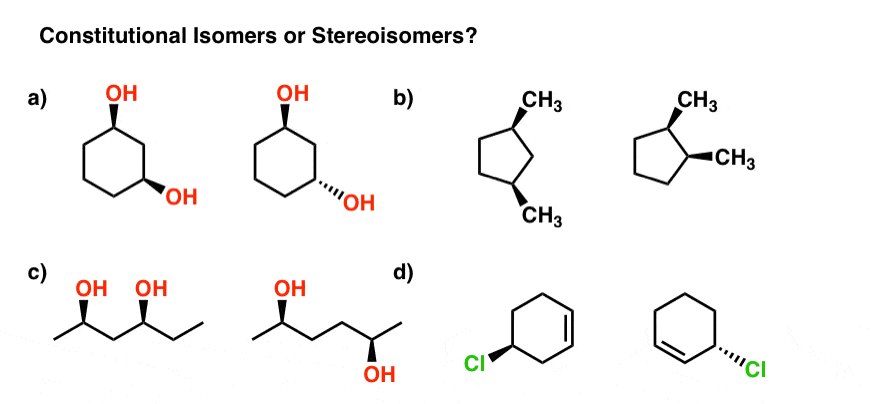
If you found this easy, don’t pat yourself on the back just yet. When drawn in line/wedge form, this question is a little too easy to be exam material. Expect to see some curveballs.
The classic way to make this type of question more challenging is to change the type of depiction, using Fischer, Newman, or a mixture of multiple projections:
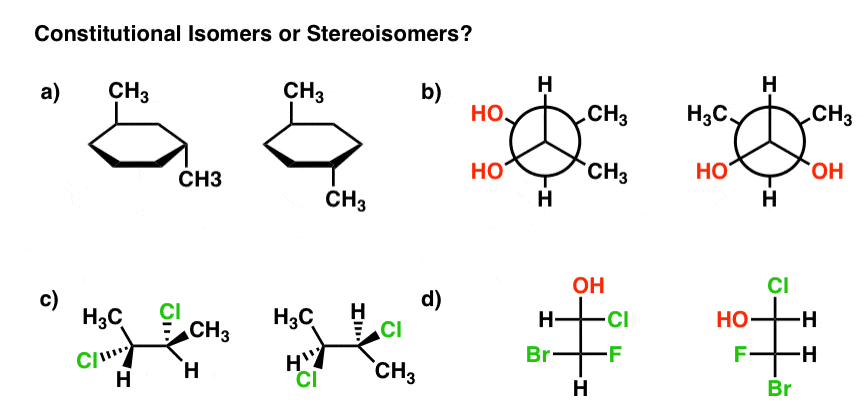
When preparing for an exam on stereochemistry, I advise trying to do pretty much every “classify these isomers” question you can until it gets boring.
The Stereochemistry Practice Quizzes have a lot of these kinds of problems (must be an MOC Member for full access). The point is to get used to solving problems for molecules in different renderings.
4. “Enantiomers vs Diastereomers vs the Same?” Some Ground Rules
Now we get to the third, and most challenging case, where we will spend the bulk of our time. “Are these molecules enantiomers, diastereomers, or the same?”.
Let’s cross off three quick wins to start:
-
First: Superimposable Molecules Are Identical
Molecules that are superimposable are considered to be identical molecules (i.e. “the same”).
Note that “superimposable” includes molecules that are
1. “superimposable through bond-rotations” (conformational isomers), as well as2.molecules that are superimposable through rotation of the whole molecule.
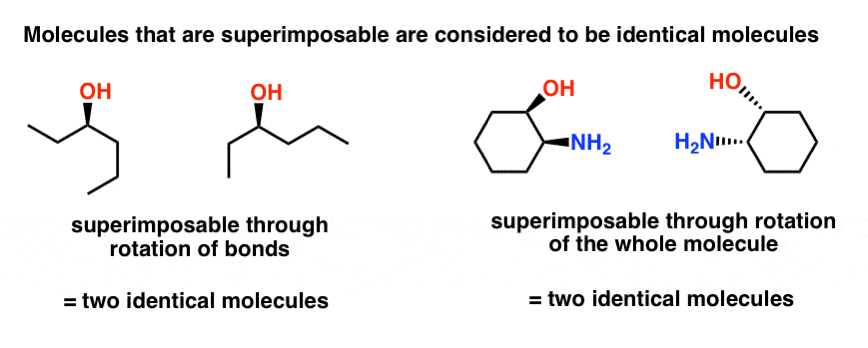
It also includes some molecules that are drawn as having stereochemistry… but don’t. Look closely ↓

Second: Recall The Key Differences Between Enantiomers and Diastereomers:
Stereoisomers always have the same connectivity. Among molecules with the same connectivity:
- Molecules that are mirror images but non-superimposable are enantiomers.
- If they aren’t superimposable, and they aren’t mirror images, then they’re diastereomers.
Third: cis-trans isomers and double-bond isomers are always diastereomers
One quick question you can always answer: double-bond isomers or cis-trans isomers will always be diastereomers.
No exceptions.
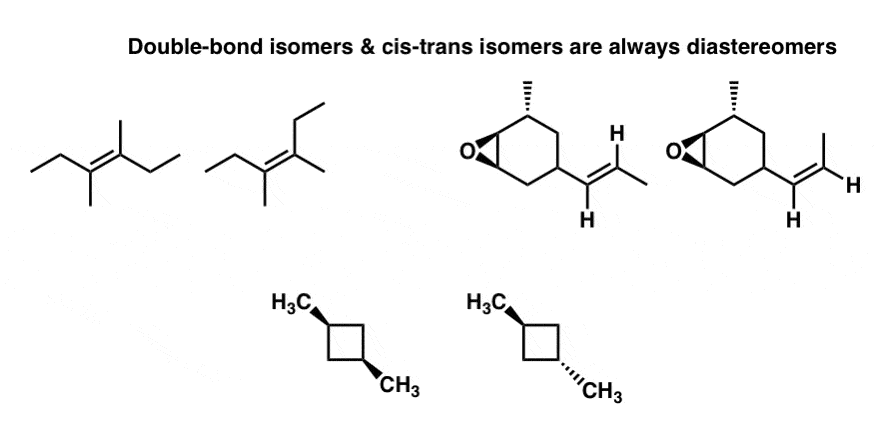
Now for the not-so-easy cases.
5. “Enantiomers vs Diastereomers vs The Same” On Molecules With Multiple Chiral Centers: Using A Model Kit
What about molecules with two or more chiral centers? Like these two examples?

Here, I have good news and bad news.
The bad news is that there is no feature on any of these molecules (like different arrangement on a double bond or ring) that allows for quick and easy determination of the relationship in < 5 seconds.
Therefore, the only way to solve these problems is to compare the configurations on each of the chiral centers and see how they relate to each other.
The good news is that these problems can be readily solved using one of two key techniques.
- One method is easy to learn but tends to require a long time to solve problems.
- The second method takes some time to get good at, but allows problems to be solved extremely quickly.
Technique #1 : Use A Model Kit
The traditional method to solve “enantiomers, diastereomers, or the same” is to build models, and see if the two molecules are superimposable or not.
By all means, start with this! Especially in a non-exam situation.
I recommend using this method the first few times you do the exercise because you have to start somewhere, and the model kit will serve as a set of training wheels to help you build confidence.
Models also help you get used to the fact that molecules are 3-dimensional objects. In this respect they are fundamentally no different from cars, cats, or any other commonplace object you care to name.
So let’s go to our “enantiomers, diastereomers, or the same” question, and try to solve each of them using models.
The first set: 2,3-dibromobutanes.
Let’s build the model of the 2,3-dibromobutane isomer using the Fischer projection. (Remember that “the arms come out to hug you”). That gives us the following model:
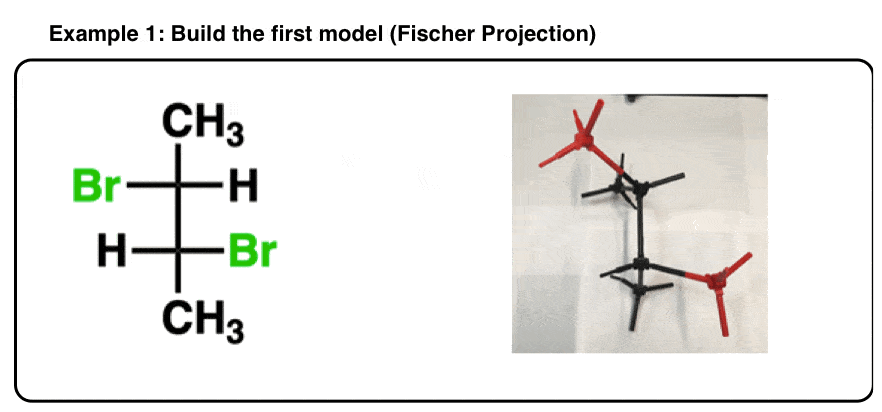
Next, we build the second model, based on the Newman projection. Here’s what the model would look like:
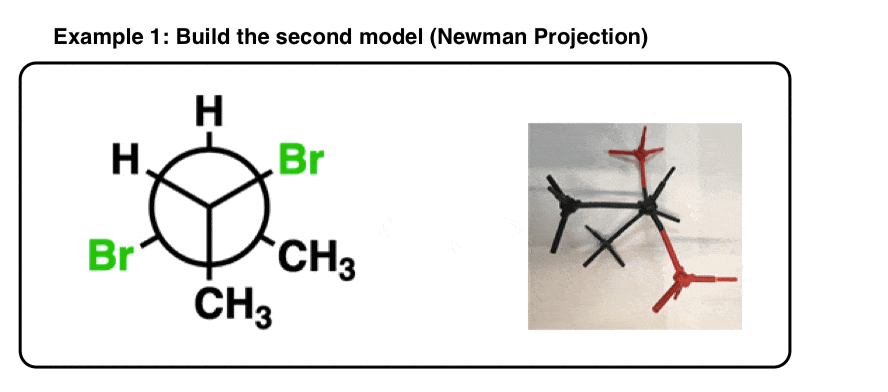
Finally, once we’ve built these two models, we can then try and move them around to see how they relate to each other.
Here, we take the model on the right hand side, and see that if we perform a rotation about the C2-C3 bond, the two molecules are actually completely superimposable!
Being superimposable, they are therefore are the same!
Let’s look at the second set.
The second set: pentan-2,3,4-triol
When we build the model for the first molecule of the set, we get the following:
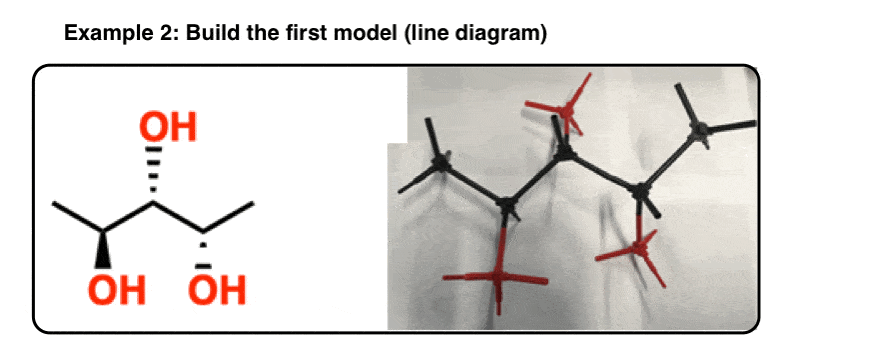
When we build the model for the second molecule of the set as a Fischer projection (remembering again that the “arms come out to hug you”) we get this:
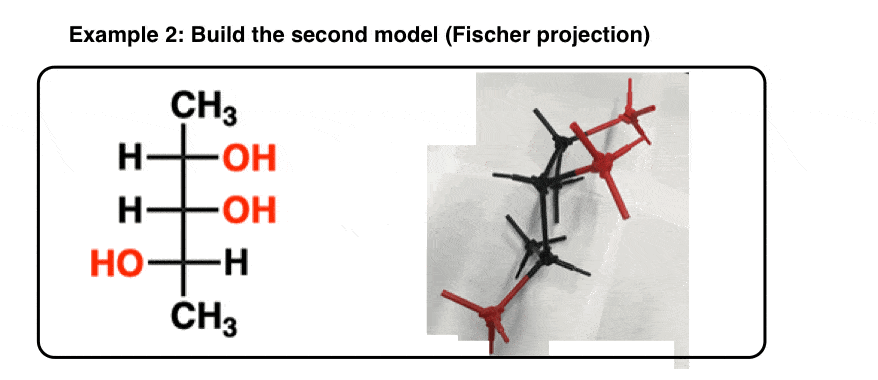
Now, let’s try to move around the molecule on the right so that we can compare it to the one on the left.
Again, these two models turn out to be the same!
6. An Easier, Faster Way (IMO) : The R/S Method
While there’s nothing wrong with making models, there is a significant drawback.
It takes time to build the darn things, and then, it takes even more time to compare the two models. While this might be OK for molecules with a stereocenter or two, model-building becomes a huge bottleneck as molecular complexity increases.
For instance, say you were asked to compare the following two molecules:

Are you really going to take ~ 5 minutes to make the models, rotate each of them around, and then compare them? Probably not.
Thankfully there is an easier way. And when you get good, you can answer these questions in less than 60 seconds.
Step 1: Start by identifying all of the chiral centers in each molecule, and determining each of their configurations as R or S.
Why is this helpful?
Take the question above. Say that you were given the full names of the two molecules, without their structures.
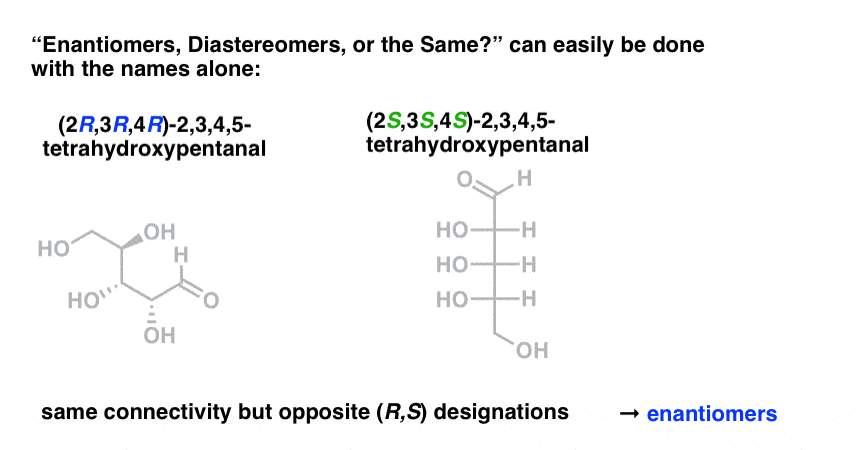
Could you figure out how these molecules are related based on the names alone?
Of course!
Because once you know the (R,S) configurations of a molecule, you can easily figure out what the configurations of its enantiomer and its diastereomers should be!
Step 2: Compare The Configurations of The Chiral Centers To Obtain Their Stereochemical Relationship
For two molecules with the same connectivity:
- The enantiomer of a molecule will always have an opposite R/S configuration. So to get the enantiomer of (2R, 3R, 4R)-2,3,4,5-tetrahydroxypentanal all we need to do is flip all the stereocenters: (2S, 3S, 4S)
- Diastereomers arise when at least two molecules share at least one (but not all) chiral center(s) with identical (R/S) configuration. So to find the diastereomers of (2R,3R,4R)-2,3,4,5-tetrahydroxypentanal , all we need to do is keep at least one stereocenter the same, and flip any or all of the rest.
- (obviously, if the two molecules have the same connectivity with all the R/S designations are the same, the two molecules are also the same)
Our molecule (2R, 3R, 4R)-2,3,4,5-tetrahydroxypentanal goes by a more pronounceable name: D-ribose.
- The enantiomer is (2S, 3S, 4S)
- There are six possible diastereomers (see below) which possess at least one (but not all) identical configuration(s) at their chiral centers.
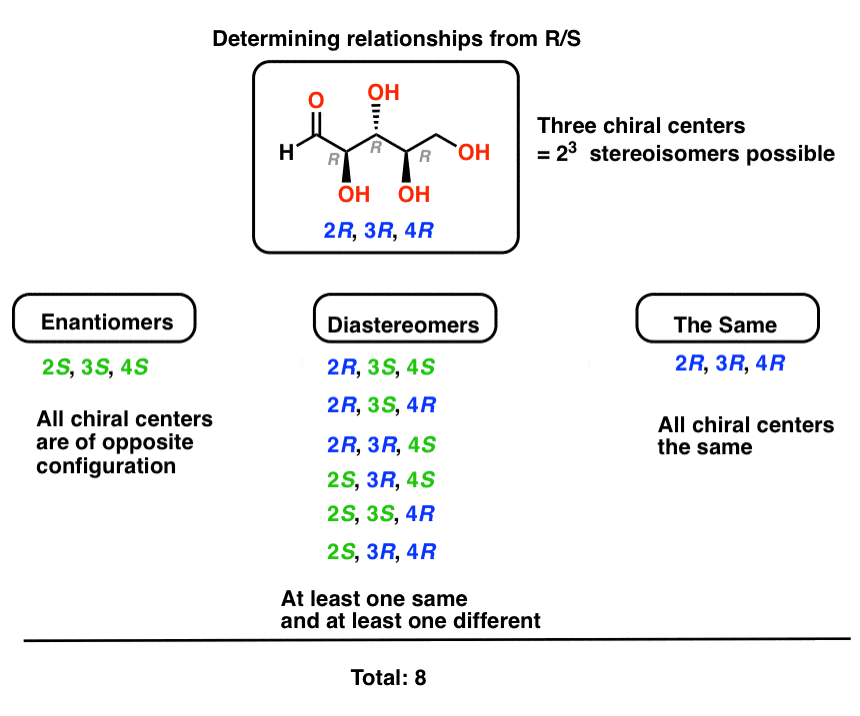
The other bonus of this method is that since it doesn’t matter what conformation (or what projection) a molecule is drawn in. Since all you’re really doing is comparing 1) connectivity and 2) configuration of stereocenters, you don’t need to worry about figuring out if two models are non-superimposable mirror images.
Let’s do a few more examples just based on the name alone.
- (S)-2-butanol and (R)-2-butanol. enantiomers, since they have opposite R,S.
- (S,R)-cyclopentane-1,2-diol and (R,R)-cyclopentane-1,2-diol. diastereomers since they share the same configuration of one of the stereocenters
- To be really ambitious, let’s do: methyl (1R,2R,3S,5S)-3- (benzoyloxy)-8-methyl-8-azabicyclo[3.2.1] octane-2-carboxylate and methyl (1S,2S,3R,5R)-3- (benzoyloxy)-8-methyl-8-azabicyclo[3.2.1] octane-2-carboxylate.
Same IUPAC descriptor, opposite (R,S)-descriptors: enantiomers.
Step 3: Double Check That They’re Not Meso
What about (S,R)-2,3-dibromobutane and (R,S)-2,3-dibromobutane? Opposite R/S, therefore enan… oh, snap. They’re actually the same.
We can’t forget to mention the one little fly that sometimes lands in the ointment: meso compounds.
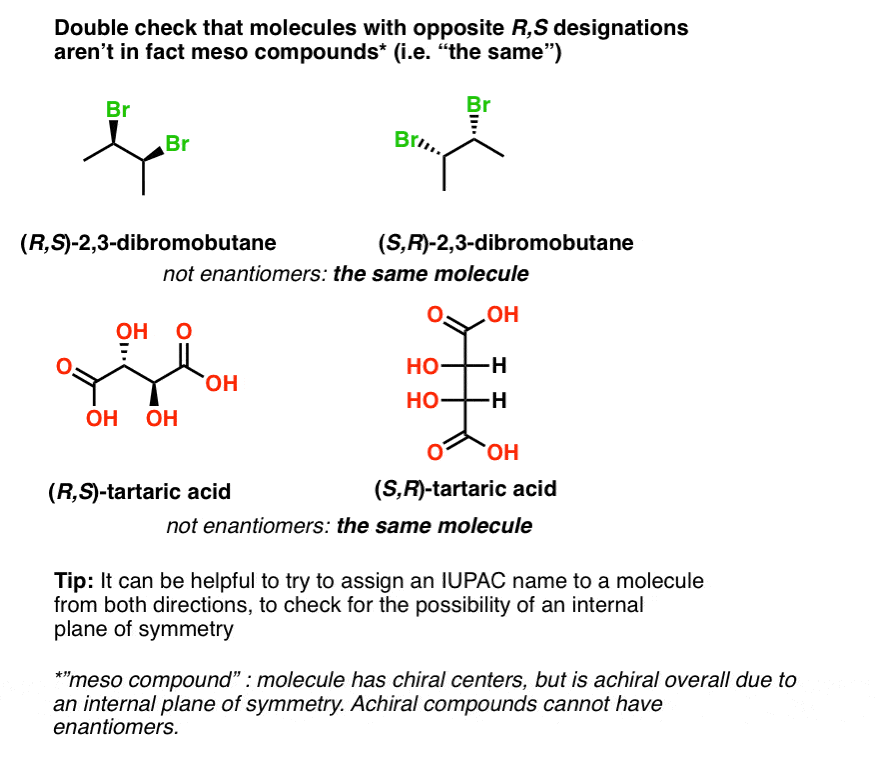
If a molecule with chiral centers has a plane of symmetry, then it can be written two equivalent ways that have the appearance of being enantiomers, but are in fact the same:
- (S,R)-2,3-dibromobutane and (R,S)-2,3-dibromobutane
- (R,S)-tartaric acid and (S,R)-tartaric acid
- (R,S)-cyclohexane-1,2-diol and (S,R)-cyclohexane-1,2-diol
So before declaring that two molecules with opposite (R,S) designations are enantiomers, double check that the molecule doesn’t have a plane of symmetry.
One way to do this is to try to name the molecule in two directions. If you obtain the same IUPAC name going left-to-right as you do going right-to-left (or clockwise / counterclockwise in the case of cyclic molecules) then you are looking at a meso compound.
7. Summary: Enantiomers vs Diastereomers vs The Same
The drawback of this final method is that it takes lots of practice to get good at quickly assigning R and S.
To that end, I recommend doing lots of exercises where you work on molecules drawn as line diagrams, Newman projections, Fischer projections, Sawhorse projections, and so on.
That’s probably enough for now. In the next post I’ll provide several examples and applications of using the R/S method to determine if molecules are enantiomers, diastereomers, or the same.
Next post: Determining R/S Configuration On A Fischer Projection
In the meantime, I recommend the following videos, since they apply these principles:
5-Video Playlist of “Enantiomers, Diastereomers, Or The Same” Problems
[Note: Thanks again to Matthew Pierce of Organic Chemistry Solutions for co-authoring. Ask Matt about scheduling an online tutoring session here. ]
Notes:
Related Articles
- Introduction to Assigning (R) and (S): The Cahn-Ingold-Prelog Rules
- Assigning Cahn-Ingold-Prelog (CIP) Priorities (2) – The Method of Dots
- How To Determine R and S Configurations On A Fischer Projection
- Assigning R/S To Newman Projections (And Converting Newman To Line Diagrams)
- The Single Swap Rule
- The Meso Trap
- What’s a Racemic Mixture?
- How To Draw A Bond Rotation
Thanks to Chlöe and the staff at IndustriousHQ for lending their steady hands towards filming the GIFs used in this post.
Quiz Yourself
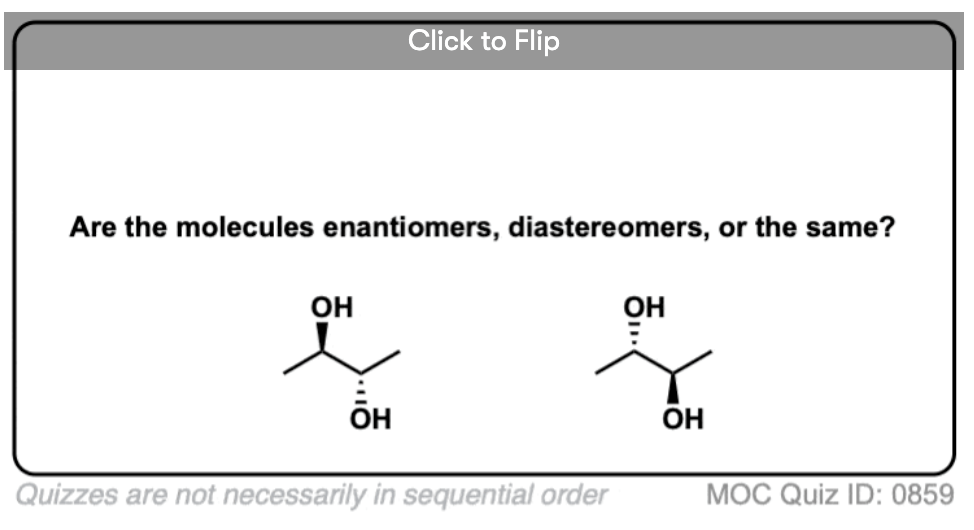
Become a MOC member to see the clickable quiz with answers on the back.
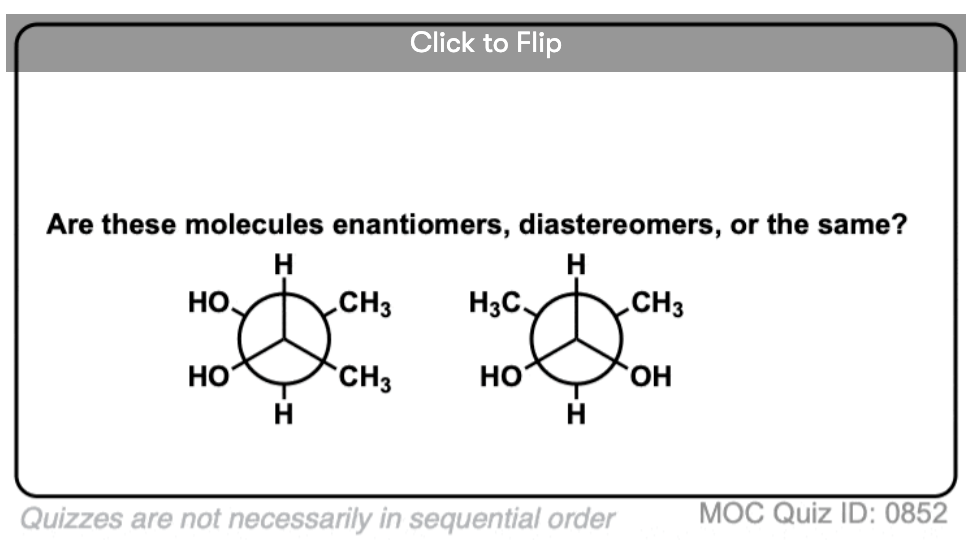
Become a MOC member to see the clickable quiz with answers on the back.
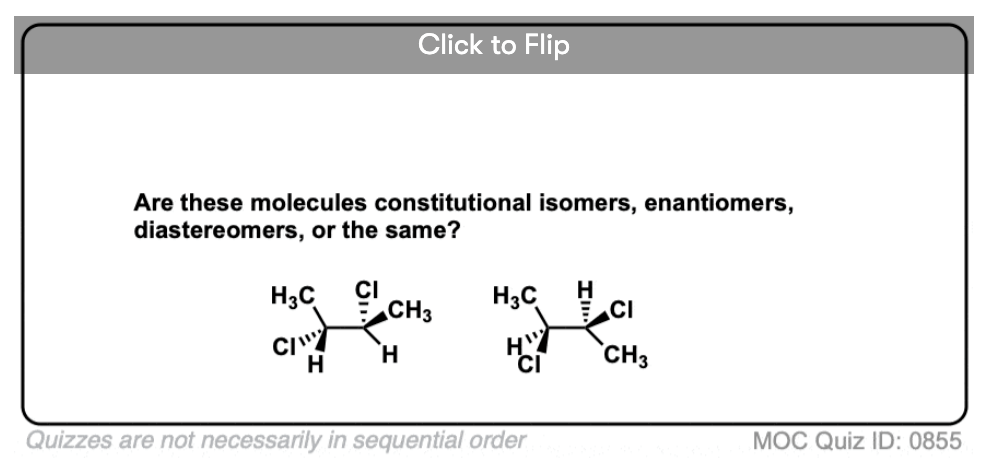
Become a MOC member to see the clickable quiz with answers on the back.
Many more “enantiomers, diastereomers, or the same” questions on the Stereochemistry Practice Quizzes page (MOC Membership required for full access).
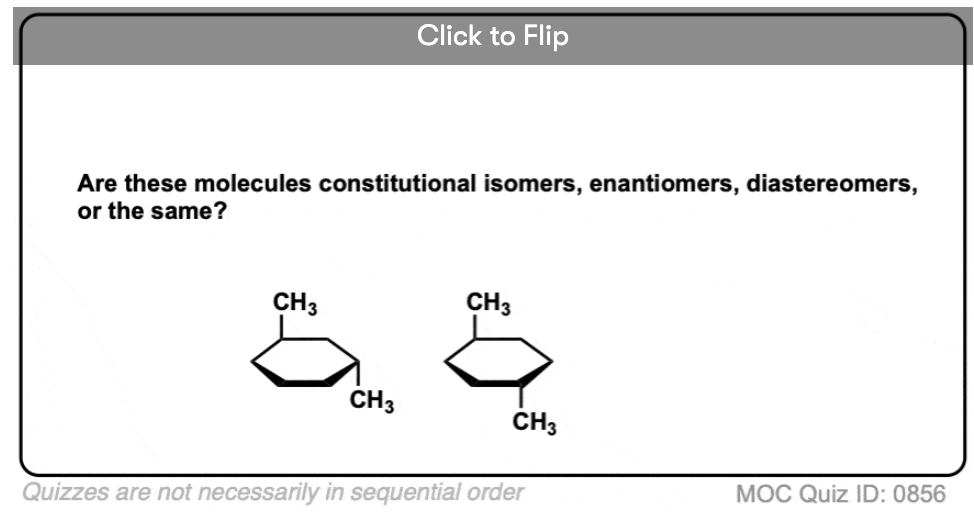
Become a MOC member to see the clickable quiz with answers on the back.
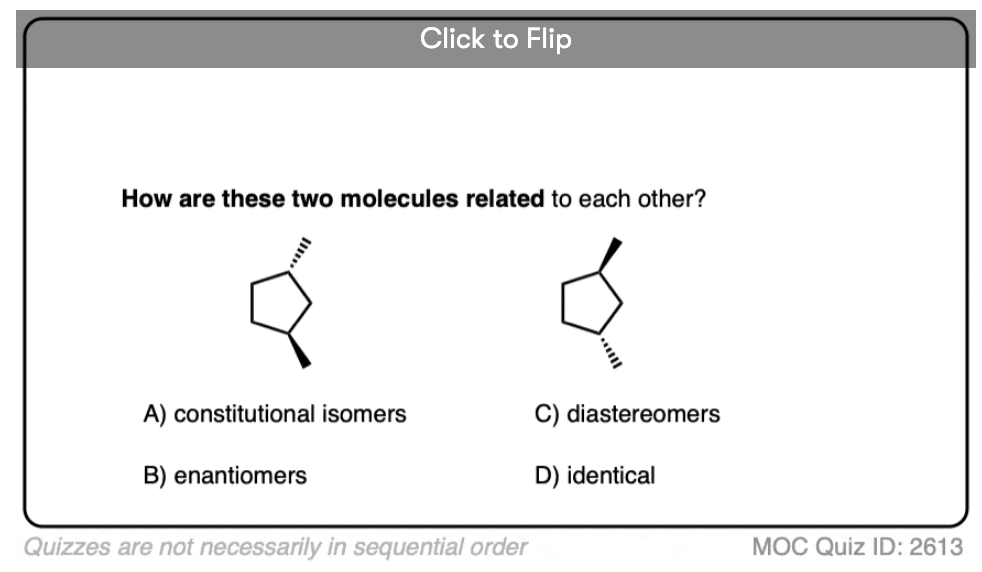
Become a MOC member to see the clickable quiz with answers on the back.
00 General Chemistry Review
01 Bonding, Structure, and Resonance
- How Do We Know Methane (CH4) Is Tetrahedral?
- Hybrid Orbitals and Hybridization
- How To Determine Hybridization: A Shortcut
- Orbital Hybridization And Bond Strengths
- Sigma bonds come in six varieties: Pi bonds come in one
- Dipole Moments and Dipoles
- A Key Skill: How to Calculate Formal Charge
- The Four Intermolecular Forces and How They Affect Boiling Points
- 3 Trends That Affect Boiling Points
- How To Use Electronegativity To Determine Electron Density (and why NOT to trust formal charge)
- Introduction to Resonance
- How To Use Curved Arrows To Interchange Resonance Forms
- Evaluating Resonance Forms (1) - The Rule of Least Charges
- How To Find The Best Resonance Structure By Applying Electronegativity
- Evaluating Resonance Structures With Negative Charges
- Evaluating Resonance Structures With Positive Charge
- Exploring Resonance: Pi-Donation
- Exploring Resonance: Pi-acceptors
- In Summary: Evaluating Resonance Structures
- Drawing Resonance Structures: 3 Common Mistakes To Avoid
- How to apply electronegativity and resonance to understand reactivity
- Bond Hybridization Practice
- Structure and Bonding Practice Quizzes
- Resonance Structures Practice
02 Acid Base Reactions
- Introduction to Acid-Base Reactions
- Acid Base Reactions In Organic Chemistry
- The Stronger The Acid, The Weaker The Conjugate Base
- Walkthrough of Acid-Base Reactions (3) - Acidity Trends
- Five Key Factors That Influence Acidity
- Acid-Base Reactions: Introducing Ka and pKa
- How to Use a pKa Table
- The pKa Table Is Your Friend
- A Handy Rule of Thumb for Acid-Base Reactions
- Acid Base Reactions Are Fast
- pKa Values Span 60 Orders Of Magnitude
- How Protonation and Deprotonation Affect Reactivity
- Acid Base Practice Problems
03 Alkanes and Nomenclature
- Meet the (Most Important) Functional Groups
- Condensed Formulas: Deciphering What the Brackets Mean
- Hidden Hydrogens, Hidden Lone Pairs, Hidden Counterions
- Don't Be Futyl, Learn The Butyls
- Primary, Secondary, Tertiary, Quaternary In Organic Chemistry
- Branching, and Its Affect On Melting and Boiling Points
- The Many, Many Ways of Drawing Butane
- Wedge And Dash Convention For Tetrahedral Carbon
- Common Mistakes in Organic Chemistry: Pentavalent Carbon
- Table of Functional Group Priorities for Nomenclature
- Summary Sheet - Alkane Nomenclature
- Organic Chemistry IUPAC Nomenclature Demystified With A Simple Puzzle Piece Approach
- Boiling Point Quizzes
- Organic Chemistry Nomenclature Quizzes
04 Conformations and Cycloalkanes
- Staggered vs Eclipsed Conformations of Ethane
- Conformational Isomers of Propane
- Newman Projection of Butane (and Gauche Conformation)
- Introduction to Cycloalkanes
- Geometric Isomers In Small Rings: Cis And Trans Cycloalkanes
- Calculation of Ring Strain In Cycloalkanes
- Cycloalkanes - Ring Strain In Cyclopropane And Cyclobutane
- Cyclohexane Conformations
- Cyclohexane Chair Conformation: An Aerial Tour
- How To Draw The Cyclohexane Chair Conformation
- The Cyclohexane Chair Flip
- The Cyclohexane Chair Flip - Energy Diagram
- Substituted Cyclohexanes - Axial vs Equatorial
- Ranking The Bulkiness Of Substituents On Cyclohexanes: "A-Values"
- Cyclohexane Chair Conformation Stability: Which One Is Lower Energy?
- Fused Rings - Cis-Decalin and Trans-Decalin
- Naming Bicyclic Compounds - Fused, Bridged, and Spiro
- Bredt's Rule (And Summary of Cycloalkanes)
- Newman Projection Practice
- Cycloalkanes Practice Problems
05 A Primer On Organic Reactions
- The Most Important Question To Ask When Learning a New Reaction
- Curved Arrows (for reactions)
- Nucleophiles and Electrophiles
- The Three Classes of Nucleophiles
- Nucleophilicity vs. Basicity
- What Makes A Good Nucleophile?
- What Makes A Good Leaving Group?
- 3 Factors That Stabilize Carbocations
- Equilibrium and Energy Relationships
- 7 Factors that stabilize negative charge in organic chemistry
- 7 Factors That Stabilize Positive Charge in Organic Chemistry
- What's a Transition State?
- Hammond's Postulate
- Learning Organic Chemistry Reactions: A Checklist (PDF)
06 Free Radical Reactions
- Free Radical Reactions
- 3 Factors That Stabilize Free Radicals
- Bond Strengths And Radical Stability
- Free Radical Initiation: Why Is "Light" Or "Heat" Required?
- Initiation, Propagation, Termination
- Monochlorination Products Of Propane, Pentane, And Other Alkanes
- Selectivity In Free Radical Reactions
- Selectivity in Free Radical Reactions: Bromination vs. Chlorination
- Halogenation At Tiffany's
- Allylic Bromination
- Bonus Topic: Allylic Rearrangements
- In Summary: Free Radicals
- Synthesis (2) - Reactions of Alkanes
- Free Radicals Practice Quizzes
07 Stereochemistry and Chirality
- Types of Isomers: Constitutional Isomers, Stereoisomers, Enantiomers, and Diastereomers
- How To Draw The Enantiomer Of A Chiral Molecule
- How To Draw A Bond Rotation
- Introduction to Assigning (R) and (S): The Cahn-Ingold-Prelog Rules
- Assigning Cahn-Ingold-Prelog (CIP) Priorities (2) - The Method of Dots
- Enantiomers vs Diastereomers vs The Same? Two Methods For Solving Problems
- Assigning R/S To Newman Projections (And Converting Newman To Line Diagrams)
- How To Determine R and S Configurations On A Fischer Projection
- The Meso Trap
- Optical Rotation, Optical Activity, and Specific Rotation
- Optical Purity and Enantiomeric Excess
- What's a Racemic Mixture?
- Chiral Allenes And Chiral Axes
- Stereochemistry Practice Problems and Quizzes
08 Substitution Reactions
- Nucleophilic Substitution Reactions - Introduction
- Two Types of Nucleophilic Substitution Reactions
- The SN2 Mechanism
- Why the SN2 Reaction Is Powerful
- The SN1 Mechanism
- The Conjugate Acid Is A Better Leaving Group
- Comparing the SN1 and SN2 Reactions
- Polar Protic? Polar Aprotic? Nonpolar? All About Solvents
- Steric Hindrance is Like a Fat Goalie
- Common Blind Spot: Intramolecular Reactions
- Substitution Practice - SN1
- Substitution Practice - SN2
09 Elimination Reactions
- Elimination Reactions (1): Introduction And The Key Pattern
- Elimination Reactions (2): The Zaitsev Rule
- Elimination Reactions Are Favored By Heat
- Two Elimination Reaction Patterns
- The E1 Reaction
- The E2 Mechanism
- E1 vs E2: Comparing the E1 and E2 Reactions
- Antiperiplanar Relationships: The E2 Reaction and Cyclohexane Rings
- Bulky Bases in Elimination Reactions
- Comparing the E1 vs SN1 Reactions
- Elimination (E1) Reactions With Rearrangements
- E1cB - Elimination (Unimolecular) Conjugate Base
- Elimination (E1) Practice Problems And Solutions
- Elimination (E2) Practice Problems and Solutions
10 Rearrangements
11 SN1/SN2/E1/E2 Decision
- Identifying Where Substitution and Elimination Reactions Happen
- Deciding SN1/SN2/E1/E2 (1) - The Substrate
- Deciding SN1/SN2/E1/E2 (2) - The Nucleophile/Base
- SN1 vs E1 and SN2 vs E2 : The Temperature
- Deciding SN1/SN2/E1/E2 - The Solvent
- Wrapup: The Key Factors For Determining SN1/SN2/E1/E2
- Alkyl Halide Reaction Map And Summary
- SN1 SN2 E1 E2 Practice Problems
12 Alkene Reactions
- E and Z Notation For Alkenes (+ Cis/Trans)
- Alkene Stability
- Alkene Addition Reactions: "Regioselectivity" and "Stereoselectivity" (Syn/Anti)
- Stereoselective and Stereospecific Reactions
- Hydrohalogenation of Alkenes and Markovnikov's Rule
- Hydration of Alkenes With Aqueous Acid
- Rearrangements in Alkene Addition Reactions
- Halogenation of Alkenes and Halohydrin Formation
- Oxymercuration Demercuration of Alkenes
- Hydroboration Oxidation of Alkenes
- m-CPBA (meta-chloroperoxybenzoic acid)
- OsO4 (Osmium Tetroxide) for Dihydroxylation of Alkenes
- Palladium on Carbon (Pd/C) for Catalytic Hydrogenation of Alkenes
- Cyclopropanation of Alkenes
- A Fourth Alkene Addition Pattern - Free Radical Addition
- Alkene Reactions: Ozonolysis
- Oxidative Cleavage of Vicinal Diols With NaIO4 and Pb(OAc)4
- Summary: Three Key Families Of Alkene Reaction Mechanisms
- Synthesis (4) - Alkene Reaction Map, Including Alkyl Halide Reactions
- Alkene Reactions Practice Problems
13 Alkyne Reactions
- Acetylides from Alkynes, And Substitution Reactions of Acetylides
- Partial Reduction of Alkynes With Lindlar's Catalyst
- Partial Reduction of Alkynes With Na/NH3 To Obtain Trans Alkenes
- Alkyne Hydroboration With "R2BH"
- Hydration and Oxymercuration of Alkynes
- Hydrohalogenation of Alkynes
- Alkyne Halogenation: Bromination and Chlorination of Alkynes
- Oxidation of Alkynes With O3 and KMnO4
- Alkenes To Alkynes Via Halogenation And Elimination Reactions
- Alkynes Are A Blank Canvas
- Synthesis (5) - Reactions of Alkynes
- Alkyne Reactions Practice Problems With Answers
14 Alcohols, Epoxides and Ethers
- Alcohols - Nomenclature and Properties
- Alcohols Can Act As Acids Or Bases (And Why It Matters)
- Alcohols - Acidity and Basicity
- The Williamson Ether Synthesis
- Ethers From Alkenes, Tertiary Alkyl Halides and Alkoxymercuration
- Alcohols To Ethers via Acid Catalysis
- Cleavage Of Ethers With Acid
- Epoxides - The Outlier Of The Ether Family
- Opening of Epoxides With Acid
- Epoxide Ring Opening With Base
- Making Alkyl Halides From Alcohols
- Tosylates And Mesylates
- PBr3 and SOCl2
- Elimination Reactions of Alcohols
- Elimination of Alcohols To Alkenes With POCl3
- Alcohol Oxidation: "Strong" and "Weak" Oxidants
- Demystifying The Mechanisms of Alcohol Oxidations
- Protecting Groups For Alcohols
- Thiols And Thioethers
- Calculating the oxidation state of a carbon
- Oxidation and Reduction in Organic Chemistry
- Oxidation Ladders
- SOCl2 Mechanism For Alcohols To Alkyl Halides: SN2 versus SNi
- Alcohol Reactions Roadmap (PDF)
- Alcohol Reaction Practice Problems
- Epoxide Reaction Quizzes
- Oxidation and Reduction Practice Quizzes
15 Organometallics
- What's An Organometallic?
- Formation of Grignard and Organolithium Reagents
- Organometallics Are Strong Bases
- Reactions of Grignard Reagents
- Protecting Groups In Grignard Reactions
- Synthesis Problems Involving Grignard Reagents
- Grignard Reactions And Synthesis (2)
- Organocuprates (Gilman Reagents): How They're Made
- Gilman Reagents (Organocuprates): What They're Used For
- The Heck, Suzuki, and Olefin Metathesis Reactions (And Why They Don't Belong In Most Introductory Organic Chemistry Courses)
- Reaction Map: Reactions of Organometallics
- Grignard Practice Problems
16 Spectroscopy
- Degrees of Unsaturation (or IHD, Index of Hydrogen Deficiency)
- Conjugation And Color (+ How Bleach Works)
- Introduction To UV-Vis Spectroscopy
- UV-Vis Spectroscopy: Absorbance of Carbonyls
- UV-Vis Spectroscopy: Practice Questions
- Bond Vibrations, Infrared Spectroscopy, and the "Ball and Spring" Model
- Infrared (IR) Spectroscopy: A Quick Primer On Interpreting Spectra
- IR Spectroscopy: 4 Practice Problems
- 1H NMR: How Many Signals?
- Homotopic, Enantiotopic, Diastereotopic
- Diastereotopic Protons in 1H NMR Spectroscopy: Examples
- 13-C NMR - How Many Signals
- Liquid Gold: Pheromones In Doe Urine
- Natural Product Isolation (1) - Extraction
- Natural Product Isolation (2) - Purification Techniques, An Overview
- Structure Determination Case Study: Deer Tarsal Gland Pheromone
17 Dienes and MO Theory
- What To Expect In Organic Chemistry 2
- Are these molecules conjugated?
- Conjugation And Resonance In Organic Chemistry
- Bonding And Antibonding Pi Orbitals
- Molecular Orbitals of The Allyl Cation, Allyl Radical, and Allyl Anion
- Pi Molecular Orbitals of Butadiene
- Reactions of Dienes: 1,2 and 1,4 Addition
- Thermodynamic and Kinetic Products
- More On 1,2 and 1,4 Additions To Dienes
- s-cis and s-trans
- The Diels-Alder Reaction
- Cyclic Dienes and Dienophiles in the Diels-Alder Reaction
- Stereochemistry of the Diels-Alder Reaction
- Exo vs Endo Products In The Diels Alder: How To Tell Them Apart
- HOMO and LUMO In the Diels Alder Reaction
- Why Are Endo vs Exo Products Favored in the Diels-Alder Reaction?
- Diels-Alder Reaction: Kinetic and Thermodynamic Control
- The Retro Diels-Alder Reaction
- The Intramolecular Diels Alder Reaction
- Regiochemistry In The Diels-Alder Reaction
- The Cope and Claisen Rearrangements
- Electrocyclic Reactions
- Electrocyclic Ring Opening And Closure (2) - Six (or Eight) Pi Electrons
- Diels Alder Practice Problems
- Molecular Orbital Theory Practice
18 Aromaticity
- Introduction To Aromaticity
- Rules For Aromaticity
- Huckel's Rule: What Does 4n+2 Mean?
- Aromatic, Non-Aromatic, or Antiaromatic? Some Practice Problems
- Antiaromatic Compounds and Antiaromaticity
- The Pi Molecular Orbitals of Benzene
- The Pi Molecular Orbitals of Cyclobutadiene
- Frost Circles
- Aromaticity Practice Quizzes
19 Reactions of Aromatic Molecules
- Electrophilic Aromatic Substitution: Introduction
- Activating and Deactivating Groups In Electrophilic Aromatic Substitution
- Electrophilic Aromatic Substitution - The Mechanism
- Ortho-, Para- and Meta- Directors in Electrophilic Aromatic Substitution
- Understanding Ortho, Para, and Meta Directors
- Why are halogens ortho- para- directors?
- Disubstituted Benzenes: The Strongest Electron-Donor "Wins"
- Electrophilic Aromatic Substitutions (1) - Halogenation of Benzene
- Electrophilic Aromatic Substitutions (2) - Nitration and Sulfonation
- EAS Reactions (3) - Friedel-Crafts Acylation and Friedel-Crafts Alkylation
- Intramolecular Friedel-Crafts Reactions
- Nucleophilic Aromatic Substitution (NAS)
- Nucleophilic Aromatic Substitution (2) - The Benzyne Mechanism
- Reactions on the "Benzylic" Carbon: Bromination And Oxidation
- The Wolff-Kishner, Clemmensen, And Other Carbonyl Reductions
- More Reactions on the Aromatic Sidechain: Reduction of Nitro Groups and the Baeyer Villiger
- Aromatic Synthesis (1) - "Order Of Operations"
- Synthesis of Benzene Derivatives (2) - Polarity Reversal
- Aromatic Synthesis (3) - Sulfonyl Blocking Groups
- Birch Reduction
- Synthesis (7): Reaction Map of Benzene and Related Aromatic Compounds
- Aromatic Reactions and Synthesis Practice
- Electrophilic Aromatic Substitution Practice Problems
20 Aldehydes and Ketones
- What's The Alpha Carbon In Carbonyl Compounds?
- Nucleophilic Addition To Carbonyls
- Aldehydes and Ketones: 14 Reactions With The Same Mechanism
- Sodium Borohydride (NaBH4) Reduction of Aldehydes and Ketones
- Grignard Reagents For Addition To Aldehydes and Ketones
- Wittig Reaction
- Hydrates, Hemiacetals, and Acetals
- Imines - Properties, Formation, Reactions, and Mechanisms
- All About Enamines
- Breaking Down Carbonyl Reaction Mechanisms: Reactions of Anionic Nucleophiles (Part 2)
- Aldehydes Ketones Reaction Practice
21 Carboxylic Acid Derivatives
- Nucleophilic Acyl Substitution (With Negatively Charged Nucleophiles)
- Addition-Elimination Mechanisms With Neutral Nucleophiles (Including Acid Catalysis)
- Basic Hydrolysis of Esters - Saponification
- Transesterification
- Proton Transfer
- Fischer Esterification - Carboxylic Acid to Ester Under Acidic Conditions
- Lithium Aluminum Hydride (LiAlH4) For Reduction of Carboxylic Acid Derivatives
- LiAlH[Ot-Bu]3 For The Reduction of Acid Halides To Aldehydes
- Di-isobutyl Aluminum Hydride (DIBAL) For The Partial Reduction of Esters and Nitriles
- Amide Hydrolysis
- Thionyl Chloride (SOCl2) And Conversion of Carboxylic Acids to Acid Halides
- Diazomethane (CH2N2)
- Carbonyl Chemistry: Learn Six Mechanisms For the Price Of One
- Making Music With Mechanisms (PADPED)
- Carboxylic Acid Derivatives Practice Questions
22 Enols and Enolates
- Keto-Enol Tautomerism
- Enolates - Formation, Stability, and Simple Reactions
- Kinetic Versus Thermodynamic Enolates
- Aldol Addition and Condensation Reactions
- Reactions of Enols - Acid-Catalyzed Aldol, Halogenation, and Mannich Reactions
- Claisen Condensation and Dieckmann Condensation
- Decarboxylation
- The Malonic Ester and Acetoacetic Ester Synthesis
- The Michael Addition Reaction and Conjugate Addition
- The Robinson Annulation
- Haloform Reaction
- The Hell–Volhard–Zelinsky Reaction
- Enols and Enolates Practice Quizzes
23 Amines
- The Amide Functional Group: Properties, Synthesis, and Nomenclature
- Basicity of Amines And pKaH
- 5 Key Basicity Trends of Amines
- The Mesomeric Effect And Aromatic Amines
- Nucleophilicity of Amines
- Alkylation of Amines (Sucks!)
- Reductive Amination
- The Gabriel Synthesis
- Some Reactions of Azides
- The Hofmann Elimination
- The Hofmann and Curtius Rearrangements
- The Cope Elimination
- Protecting Groups for Amines - Carbamates
- The Strecker Synthesis of Amino Acids
- Introduction to Peptide Synthesis
- Reactions of Diazonium Salts: Sandmeyer and Related Reactions
- Amine Practice Questions
24 Carbohydrates
- D and L Notation For Sugars
- Pyranoses and Furanoses: Ring-Chain Tautomerism In Sugars
- What is Mutarotation?
- Reducing Sugars
- The Big Damn Post Of Carbohydrate-Related Chemistry Definitions
- The Haworth Projection
- Converting a Fischer Projection To A Haworth (And Vice Versa)
- Reactions of Sugars: Glycosylation and Protection
- The Ruff Degradation and Kiliani-Fischer Synthesis
- Isoelectric Points of Amino Acids (and How To Calculate Them)
- Carbohydrates Practice
- Amino Acid Quizzes
25 Fun and Miscellaneous
- A Gallery of Some Interesting Molecules From Nature
- Screw Organic Chemistry, I'm Just Going To Write About Cats
- On Cats, Part 1: Conformations and Configurations
- On Cats, Part 2: Cat Line Diagrams
- On Cats, Part 4: Enantiocats
- On Cats, Part 6: Stereocenters
- Organic Chemistry Is Shit
- The Organic Chemistry Behind "The Pill"
- Maybe they should call them, "Formal Wins" ?
- Why Do Organic Chemists Use Kilocalories?
- The Principle of Least Effort
- Organic Chemistry GIFS - Resonance Forms
- Reproducibility In Organic Chemistry
- What Holds The Nucleus Together?
- How Reactions Are Like Music
- Organic Chemistry and the New MCAT
26 Organic Chemistry Tips and Tricks
- Common Mistakes: Formal Charges Can Mislead
- Partial Charges Give Clues About Electron Flow
- Draw The Ugly Version First
- Organic Chemistry Study Tips: Learn the Trends
- The 8 Types of Arrows In Organic Chemistry, Explained
- Top 10 Skills To Master Before An Organic Chemistry 2 Final
- Common Mistakes with Carbonyls: Carboxylic Acids... Are Acids!
- Planning Organic Synthesis With "Reaction Maps"
- Alkene Addition Pattern #1: The "Carbocation Pathway"
- Alkene Addition Pattern #2: The "Three-Membered Ring" Pathway
- Alkene Addition Pattern #3: The "Concerted" Pathway
- Number Your Carbons!
- The 4 Major Classes of Reactions in Org 1
- How (and why) electrons flow
- Grossman's Rule
- Three Exam Tips
- A 3-Step Method For Thinking Through Synthesis Problems
- Putting It Together
- Putting Diels-Alder Products in Perspective
- The Ups and Downs of Cyclohexanes
- The Most Annoying Exceptions in Org 1 (Part 1)
- The Most Annoying Exceptions in Org 1 (Part 2)
- The Marriage May Be Bad, But the Divorce Still Costs Money
- 9 Nomenclature Conventions To Know
- Nucleophile attacks Electrophile
27 Case Studies of Successful O-Chem Students
- Success Stories: How Corina Got The The "Hard" Professor - And Got An A+ Anyway
- How Helena Aced Organic Chemistry
- From a "Drop" To B+ in Org 2 – How A Hard Working Student Turned It Around
- How Serge Aced Organic Chemistry
- Success Stories: How Zach Aced Organic Chemistry 1
- Success Stories: How Kari Went From C– to B+
- How Esther Bounced Back From a "C" To Get A's In Organic Chemistry 1 And 2
- How Tyrell Got The Highest Grade In Her Organic Chemistry Course
- This Is Why Students Use Flashcards
- Success Stories: How Stu Aced Organic Chemistry
- How John Pulled Up His Organic Chemistry Exam Grades
- Success Stories: How Nathan Aced Organic Chemistry (Without It Taking Over His Life)
- How Chris Aced Org 1 and Org 2
- Interview: How Jay Got an A+ In Organic Chemistry
- How to Do Well in Organic Chemistry: One Student's Advice
- "America's Top TA" Shares His Secrets For Teaching O-Chem
- "Organic Chemistry Is Like..." - A Few Metaphors
- How To Do Well In Organic Chemistry: Advice From A Tutor
- Guest post: "I went from being afraid of tests to actually looking forward to them".
I love you brother….I can’t explain you how much this helped…God Bless you
Thanks for explaining the differences between enantiomers, diastereomers, and the same molecule. It’s really helpful to understand how these concepts relate to solving problems in chemistry. Can you provide more examples or case studies that illustrate how these principles can be applied in practice?
Thank you, you are great
Glad you find it useful, thank you!
Hi I’m a bit stuck – could anyone help me with an enabtiomer of octinoxate and a diasereomer of it as well please? I can’t figure it out – thank you.
Look for the chiral center in the structure. You will see a carbon attached to an ethyl group, a butyl group, a CH2O group and a (hidden) hydrogen.
One arrangement of the 4 atoms around that carbon will give you one enantiomer. Then flip the configuration of any two groups around that carbon to give you the enantiomer.
Finally, to get a diastereomer, change the double bond from trans to cis.
Is constitutional isomers and diastereomers same?
And in first que i.e. 2,3 hydroxy butane, when i convert these zig zag molecules in fischer, i am getting enantiomers.
No, constitutional isomers and diastereomers are not the same.
By, “the same”, I mean that sometimes you are going to be asked questions on exams where two identical molecules are drawn in different ways, and it will be important that you be able to recognize that!
I am an analytical chemist. I am identifying the alkylate streams produced in a refinery.
For this project I purchased 3,4-dimethylheptane and 2,3,4-trimethyl hexane.When I injected these two isomers in separate a dilute solution in isooctane each I observed that each compound produce a doublet peak. The MS pattern was identical for each doublet peak. The peaks in each case are about 80 % separated. Now the column I used to separate these is a 100 meter-0.25mm-0.5 micron non-polar. The literature reports that stereoisomers can not be separated but in specialized columns such as liquid ionic column or chiral columns. The column I used is a standard capillary column.
Here is my question of the 4 stereoisomers rendered by each of the 2 molecules which are responsible for each peak that I observed in the MS. I know each molecule has RR,SS,RS,SR . Which pair is responsible for the peak the two peaks.
Hi, Essentially what you’ve done is separate pairs of diastereomers, which have slightly different physical properties. For 3,4-dimethylheptane the two peaks will be the RR/SS pair (which will show up as one peak, because you have a non-chiral column) and the RS/SR pair (which will also show up as one peak). It’s impossible to know which peak corresponds to which set without an authentic sample of one of the four isomers, co-injected with your sample.
To answer in a longer form, you have 4 stereoisomers. The RR and SS are enantiomers of each other, and each are diastereomeric to the RS/SR. That means your RR/SS will have different physical properties than the RS/SR. But since you are using an achiral column you won’t be able to separate RR from SS.
The same holds for RS and SR. These enantiomers of each other, but are each diastereomers to RR/SS and will have slightly different physical properties, including polarity (which is why they elute at a slightly different time on the column).
I hope this answers your question. James
Thanks a lot for this material, searching for this from long time, you are awesome
In the second set of example of the 5th point (enantiomers vs diastereomers vs the same), what will be the R/S designation of the second chiral carbon? I am having problems in assigning the 1st and the 2nd priority…
Great question! I think you mean, second and third priority since the OH will be 1st. In this case the middle carbon is not a chiral center. It is attached to H, OH and two -CH(OH)CH3 groups each with an (S) configuration. Since it is attached to two identical substituents it is not a chiral center.
However if instead of (2S, 4S) the molecule were (2S, 4R) or (2R, 4S) then the center carbon would be attached to two different groups (even though they have the same connectivity, different because one is R and one is S). In this case it would be a “pseudo-asymmetric” center. I deliberately avoided an example of this to keep things simple. https://goldbook.iupac.org/terms/view/P04921
the top part:
“The three important distinctions are:
isomers (same molecular formula) versus non-isomers (different molecular formula)
constitutional isomers (same connectivity) versus stereoisomers (different arrangement in space)”
shouldn’t it say …constitutional isomers (different connectivity)…?
-Rachel
Shoot, you’re right. Thanks for the catch!
I have one extra little thing to add about assigning R/S to determine stereochemical relationships: you don’t even have to get the priorities correct! As long as you are consistent with the priorities you assign for each group on the different molecules, you should still get the correct relationship. This can shave a few seconds off the time it takes to complete an exam.